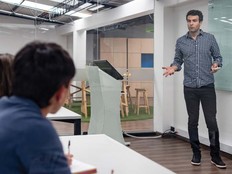UB Tech 2019: University of Alabama at Birmingham Moves the Needle on User Experience
When the University of Alabama at Birmingham embarks on its next four-year strategic plan, campus leaders will focus on easing points of friction as students, faculty, researchers and community members navigate through the UAB ecosystem, said Curtis Carver, vice president for IT and CIO, at the UB Tech conference in Orlando, Fla.
Carver delivered the event’s closing keynote, “Storytelling Comes to IT (with the Help of AI),” on Wednesday.
JOIN THE CONVERSATION: Follow @EdTech_HigherEd on Twitter for continued UB Tech coverage.
Those points of friction — UAB calls them “digital moments” — may appear small, but they are far from inconsequential, said Carver. They arise, for example, at the moment a potential student seeks to sign up for a campus tour or a faculty member is prompted to change a password.
When these moments are cumbersome, intrusive or illogical, they create frustration, waste time and may even discourage individuals from joining a particular institution, Carver said.
In an era when competition for students is fierce and many colleges are taking a hard look at financial sustainability, that’s a big risk.
“Colleges fail because they don’t meet the needs of their customers. They have disgruntled customers, and those disgruntled customers go somewhere else,” Carver said. “Our next strategic plan is going to be about the stories of our customers and how do we delight — hopefully that’s the one word you take away from this presentation — how do you delight your customer.”
Digital Touchpoints Can Help or Hinder the Campus User Experience
Four years ago, when Carver joined UAB, many day-to-day processes were typical of higher education institutions. Yet once leaders began taking a closer look, they discovered vast room for improvement.
For example, a prospective student who wanted to sign up for a campus visit had to endure a multistep process that required a user name, password and answers to several questions. It was frustrating and, Carver said, unnecessary.
It was also unwise, he said, considering that this potential student is also a potential paying customer.
“We’re actually building active roadblocks and obstacles to them giving us money,” he said. “It’s well intentioned, but they’re viewing it from their back office rather than viewing it from the perspective of [the student].”
Today, a student who wants to visit UAB goes online to answer three questions: What’s their name, when will they visit and how many people will be coming?
“That’s all I really need to know,” Carver said. “It’s kind of like a first date. Why do I need your user name and password? I don’t.” The UAB team has undertaken similar revisions across its campus, including making it easier for faculty to manage passwords, use email, access storage and handle routine queries from students.
Assess Digital Interactions with the Goal of Eliminating Friction
Driving all these improvements, said Carver, is the objective of making it easier for staff, students and faculty to do their jobs by ensuring that technology is a facilitator, not an obstacle.
“What can I take off your plate?” he said. “How can I delight you by taking email or patching or storage off your plate? That leads to that emotional connection and that leads to delight.”
As another example, faculty used to undergo a laborious process to enter students’ grades into the appropriate system at the end of the semester. It required multiple hours and mouse clicks, and one error created havoc. The process essentially turned faculty into “expensive typists,” Carver said.
Today, the grading system is automated, accurate and easy — because someone took the time to look at the existing process and figure out a better way, Carver said.
Cumulatively, such changes can have dramatic impact, supporting members of the community in ways that make individuals — and the institution — more likely to succeed.
“If you’re taking linear, incremental steps and other institutions are taking exponential steps forward, that means you’re falling behind exponentially, and you will go out of business exponentially,” said Carver.
That’s why UAB’s strategy, he said, is to focus on “digital moments,” the points that occur in the individual’s start-to-finish journey. He advised leaders to map out each stage of the journey for each group of stakeholders and enlist their help in creating solutions.
“What’s getting in their way?” he said. “I would suggest many universities haven’t thought about this.”
UAB’s next innovation will be an artificial intelligence-driven chatbot, AskBlaze, that’s integrated into the UAB app so it’s accessible to staff and students on their phones to answer FAQs about a variety of topics.
The university has also rolled out an AI system that sends messages to students based on predetermined triggers, such as a student acing (or failing) a midterm.
The benefit of that system is twofold, Carver said: It takes work away from busy faculty, and it creates a point of connection with students, who are more likely to engage with the institution in return.
“Instead of our customers being in the background, they’re going to be in the foreground — their journey at our institution and how that becomes better,” Carver said.
Follow EdTech’s coverage of the 2019 UB Tech Conference here.









